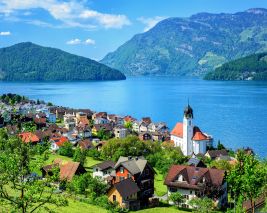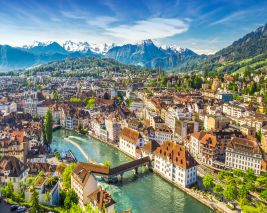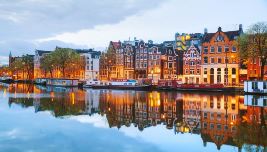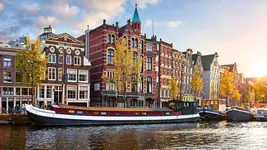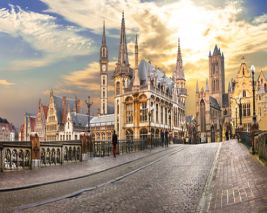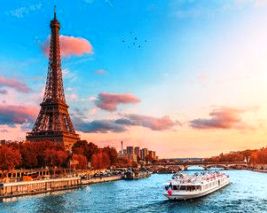From Art to Adventure - The Netherlands
From the many fascinating museums to the majestic old windmills, from the vibrant tulip fields to the glorious canals, from the walks down the historic narrow lanes to romantic candle-lit dinners in the charming cafes, The Netherlands is one destination that leaves you absolutely spellbound, wherever you look.
The Netherlands is a small European country that shares its eastern and southern borders with Germany and Belgium respectively, while being connected to the sea in the northern and western areas. The country is an extremely popular travel destination thanks to its rich cultural heritage, fascinating historical architecture, impressive modernisation and so much more.
If you are looking to immerse yourself in an experience of alluring beauty, exquisite art, refreshing bicycle trips and exhilarating bicycle tours, while having a lot of fun all along the way, you are sure to fall in love with The Netherlands!
| Netherlands Tourism : A Quick Overview |
| Continent |
Europe |
| Capital |
Amsterdam |
| Official Language |
Dutch, English |
| Dial Code |
+31 |
| Population |
17,336,891 |
| Currency |
Euro |
| Time Zone |
UTC + 1 and UTC + 2 |
| Area |
41,543 km² |
Highlights Of Netherlands:
Netherlands tourism offers many delightful surprises. From choosing how to reach Netherlands and places to visit Netherlands to discovering the secrets and cultural implications of the Netherlands travel guides, there are a lot of fun activities. Here are the highlights of the Netherlands tourism:
- The artistic heritage of the Netherlands consists of many renowned artists, including Rembrandt and Van Gogh. World-class museums such as the Rijksmuseum and the Van Gogh Museum feature works of art by many celebrated artists.
- The Netherlands is an innovative hub. Cities like Rotterdam are not only the pride and joy of Netherlands tourism for their beauty but also for their cutting-edge architectural designs. They reflect the forward-thinking mentality of the population.
- During the Netherlands tourism, you can pick up a bicycle and traverse through the places to visit Netherlands. There’s an extensive cycling culture and a network of paths that facilitates bike-friendly escapades, which also promotes environmental preservation.
- Places to visit Netherlands, such as Kinderdijk and Zaanse Schans, are known for their efforts in windmill preservation and smart water management.
Netherlands Cities:
The Netherlands is home to some of the finest cities in the world. Amsterdam, the capital of the country, is known for its gorgeous canals, fine cobbled streets, museums like the Van Gogh Museum and Rijksmuseum, electric nightlife and a very popular red-light area.
Another extremely popular city in The Netherlands is The Hague, known world over for being home to the U.N.’s International Court of Justice. Apart from the formidable presence of the one of the most powerful centres of justice, the city also houses the government seat and the royal family.
If you are looking for a glimpse into the simpler times, then Utrecht and Delft are the cities to visit, with gorgeous canals winding around the medieval areas of the cities. Both these cities are popular for their lively atmospheres, especially in the evenings so do try to stay around till the single day-trip crowd has left.
Rotterdam is another city in The Netherlands that you just can’t miss out on. It is the second largest city in the country and one of the busiest trading ports in the world. During the Second World War, Rotterdam was amongst the few Dutch cities to have incurred the maximum damage, and today you can see how the city has moved on from those turbulent times with modern architecture and futuristic buildings as well.
From futuristic architecture to a throwback to everything synonymous with The Netherlands, Haarlem is the one city that offers the best of both worlds. Buildings with old Dutch architecture, canals twisting their way throughout the city, lovely tulip fields and a host of iconic windmills - this city drowns you in the old-world charm of The Netherlands.
For cheese lovers, a visit to the city of Alkmaar between the months of April and September is a must, as there’s an expansive cheese market every Friday morning letting you enjoy a truly unique experience.
Popular Tourist Spots In Netherlands:
Amsterdam Canal Rings:
When you think about The Netherlands, one of the first experiences that comes to mind is exploring the intricate canals all over the country. The Canal Ring of Amsterdam is one of the most popular and gorgeous canal rings in the country. Built in the 17th century, the three main canals in this system form concentric rings around the capital, and this is referred to as Grachtengordel. In case you want to visit canal systems that are less busy and take you deep into the medieval structures of the country, we recommend exploring the canals in Utrecht and Delft.
Dikes of Zeeland:
Zeeland is the peninsular region in the southwest of The Netherlands, and sees the three main rivers – Rhine, Mass and Schelde – come together. The area also includes numerous lovely islands. This region of land has been formed quite recently and is below the sea level. The area thus has to rely upon the massive dikes formed naturally in order to stay habitable. Another highlight of Zeeland is the Delta Works, which is a collection of futuristic dams. This project is considered one of the Seven Wonders of the Modern World.
Hoge Veluwe National Park:
It may be a tiny country, but The Netherlands can still be a proud claimant of being home to one of the most diverse national park structures on earth. The Hoge Veluwe National Park is the largest national park in the country, sprawling across an impressive 13,800 acres. It is a marvellous nature reserve and home to several elements like woodlands, sand dunes, heathlands, numerous wildlife species and an intriguing sculpture park. The area is a popular one for bird watching, hiking and biking. The best-known part of this national park is, however, an art museum. The Hoge Veluwe is home to the Kroller-Muller Museum, which features the second largest collection of Van Gogh's works in the world, along with featuring several prominent artist's works.
Van Gogh Museum and The Rijksmuseum:
The Van Gogh Museum in Amsterdam was built as a tribute to one of the greatest artists of all times, with over 1000 pieces of his work being on display. The museum attracts more than one and a half million visitors annually, each leaving the museum awestruck. Apart from the works of Van Gogh, contributions from his contemporaries are also on display in this museum.
Keeping on the museum trail, any trip to The Netherlands is incomplete without a visit to The Rijksmuseum, also known as The Dutch National Museum. Built in the year 1809, the museum today boasts of having one of the biggest art collections in the world, with over 7 million works of art being on display. With a collection of impressive magnitude, one day might not be enough to completely take in everything that the Rijksmuseum has to offer.
Keukenhof:
Colourful and lively belts of Tulips is a sight that most people associate with The Netherlands. The best place to experience this sight in all its glory is Keukenhof, also called the Garden of Europe. Visiting Keukenhof in springtime is a blissful experience, with tulips and other flowers blooming spectacularly and forming what is known as the ‘bulb belt’. Over 700 varieties of tulips and a number of other flower varieties can be witnessed in the largest public garden of Europe, which spreads the charm of its exquisite flowers over 70 acres of land.
Adventure Sports In Netherlands:
Apart from the rich cultural and historical experiences and lighter outdoor activities like boating and cycling, one can also enjoy a host of adventure activities when in The Netherlands. Amongst the most popular sites for adventure activities is Rotterdam, where visitors can zipline or abseil from Euromast, a 100-metre-high tower. People who love climbing can enjoy the unique experience of climbing the world’s tallest free-standing wall in Groningen, named Excalibur.
The 37-metre-high wall offers a steep climb with daunting curves that take some experience to master. A rare adventure activity that one can enjoy in The Netherlands is ice skating on the canals in Amsterdam. Although it is not a regular occurrence, there are some winters when the temperatures drop to zero and below, freezing the canals and making for really fun ice-skating sites. Other adventure activities that one can experience in different parts of The Netherlands include bungee jumping, mudflat hiking, parachute jumping and mountain biking.
Cuisine Of Netherlands:
While Dutch cuisine is not the most popular around the world, there are still quite a few Dutch delicacies that you must try on a visit to The Netherlands. Bitterballen is a popular Dutch snack, with these deep-fried meatballs melting away in your mouth immediately and the mustard sauce adding a nice touch to the flavours. Hollandse Nieuwe is another popular dish, with fish lovers falling in love with it with the first bite itself. Gherkins and chopped onions are served on the side of raw herring, which is supposed to be eaten in a traditional Dutch manner by lifting the herring up in the air by the tail and taking upward bites. Stroopwafel is probably the most famous dish from The Netherlands, with this cookie being made from two thin waffles being stuck to each other using a sweet syrup layer.
Interesting facts about The Netherlands:
Netherlands tourism is a cornucopia of new experiences and learning. There are many aspects of the country that you can learn from the Netherlands travel guides, and there is a lot more that the Netherlands tour guides can share when you visit the various sites. Here are a few interesting facts to check out in the Netherlands tourism:
- The Netherlands is the world’s largest flower exporter, constituting 80% of the market. Their speciality is tulip bulbs , of which 4.3 billion are exported.
- The Netherlands has preserved over 1000 windmills, some of which you can visit with a Netherlands tour guide.
- Netherlands tourism is widely known for its waterways commute. There are many solutions for how to reach Netherlands by waterways, and within the country, there are over 4400 km of navigable rivers, canals, and lakes.
- Netherlands consistently ranks among the world’s happiest countries, reflecting high levels of social and institutional trust.
- Men from The Netherlands are the tallest in the world, with an average height of 6 feet or 1.83 metre.
- According to the World Happiness Report released every year by the United Nations, The Netherlands is the happiest country in the world.
- On April 1st, 2001, The Netherlands became the first country in the world to legalise same-sex marriage, highlighting its progressive culture. Places to visit Netherlands.
You can also learn a lot of interesting details about the country at the . There are also interesting facts and historic details shared by the Netherlands travel guides.
Netherlands Location:
The Netherlands is located in the north-western part of Europe, and shares its borders with 2 countries, Germany on the east and Belgium to the South, with the other sides opening up at the sea. The strategic location of the country makes it easier to identify suitable means of how to reach Netherlands.
The location of the Netherlands also inspires trade hubs and cultural exchange within the European Union. The landscape is flat, much of which lies below sea level. It helps constitute an elaborate system of dikes and polders, showcasing the country’s dedication to innovative approaches towards water management. You can visit many such sites and explore the techniques with the Netherlands tourism.
Best time to visit in Netherlands:
The best time to visit The Netherlands is between April and October. April and May experience blossoms of tulips and other spring bulbs, making for a colourful visit for the travellers. While the weather is at its best in the summer months of June, July and August, they are also the busiest and art aficionados might not enjoy visiting the overcrowded museums. If you are someone who wants to enjoy the marvels of various artists in peace, then September and October are the months to visit the country.
Let’s discuss the weather conditions affecting the Netherlands tourism in a little more detail so you can identify the best time to visit Netherlands as per your preferences:
- Spring (March to May) - This is the best time to visit Netherlands for nature lovers. You can witness the iconic tulips in full bloom, with the peak month being April. The Keukenhof Gardens are particularly celebrated during this season for their beauty and charm in the Netherlands tourism.
- Summer (June to August) - This is the best time to visit Netherlands if you want to explore the towns and partake in outdoor activities. The weather is pleasant, and several festivals are celebrated in the summer. You can hire a Netherlands tour guide to explore the places to visit Netherlands with ease.
- Autumn (September to November) - This is the best time to visit Netherlands for cultural excursions. Not only can you witness the divinity of the changing foliage, but you can also partake in cultural events in the Netherlands tourism.
- Winter (December to February) - During this season, it is relatively cold. Netherlands tourism thrives at this time due to festive holiday markets and opportunities for ice skating on natural waterways.
You can choose the best time to visit Netherlands based on your preference for climate, budget, and activities.
How to get to The Netherlands:
By Air: The biggest airport in the country, Schiphol Airport, is well connected to most international destinations in the world. You can get flights to The Netherlands from most major Indian cities. Direct flights are also available from New Delhi and Mumbai to Amsterdam. In case you do not find a direct flight, flights to Dusseldorf International Airport in Germany and Brussels Airport in Belgium can also be taken to reach The Netherlands.
By Train: The Netherlands is connected to other major parts of Europe by two rail networks. The Thalys connects the country to France and Belgium, and the ICE connects The Netherlands to Germany, Poland, Switzerland and Denmark. There are also regional trains along these networks that connect The Netherlands to these countries and are cheaper alternatives to Thalys and ICE.
By Road: One can drive to The Netherlands through Germany or Belgium, provided you have the required road permits.
By Water: There are three ferry services that are run from the UK to The Netherlands – P&O Ferries, Stena Line and DFDS Seaways - that can be taken by tourists to reach the country by sea.
History Of Netherlands:
The Netherlands has a history of being caught up between power struggles of several different powers, starting with the struggles between the Roman Empire and Germanic people. The country slowly came out of the power struggles and established itself as one of the forces to reckon with, thanks to flourishing trade and sizeable armies, and reached its peak in the late 1600s. As the power declined eventually, the county was captured by the UK around the end of the next century. The Dutch won their freedom back, and flourished for several years, before again succumbing to another powerful enemy, this time the Nazis during the second world war. The people from the country came out of this situation stronger than before, which is just another testament to the resilience of the Dutch people.
If you’re already envisioning yourself walking down cobbled streets, sipping beer by the canals, or just enjoying the sight of endless Tulips, explore the Thomas Cook packages to The Netherlands and book your next holiday!














